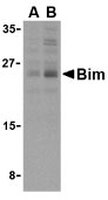202000 Sigma-AldrichAnti-Bim (22-40) Rabbit pAb
Recommended Products
Overview
| Replacement Information |
|---|
Key Specifications Table
| Host |
|---|
| Rb |
| Description | |
|---|---|
| Overview | This product has been discontinued. We are offering Anti-Bim Antibody, internal epitope, pan-Bim isoforms (Cat. No. AB17003) as a possible alternative. Please read the alternative product documentation carefully and contact technical service if you need additional information. |
| Catalogue Number | 202000 |
| Brand Family | Calbiochem® |
| Synonyms | Anti-BOD |
| Application Data |  Detection of human Bim by immunoblotting. Samples: Whole cell lysate from K562 cells at primary antibody dilutions 2.5 µg/ml (lane A) and µg/ml (lane B). Primary antibody: Anti-Bim (22-40) Rabbit pAb (Cat. No. 202000) (5 µg/ml). Detection: chemiluminescence.  Detection of human Bim by immunocytochemistry. Sample: K562 cells. Primary antibody: Anti-Bim (22-40) Rabbit pAb (Cat. No. 202000) (10 µg/ml). Detection: fluorescence. |
| References | |
|---|---|
| References | Hsu, S.Y., et al. 1998. Mol. Endocrinol. 12, 1432. O’Connor, L., et al. 1998. EMBO J. 17, 384. |
| Product Information | |
|---|---|
| Form | Liquid |
| Formulation | In PBS. |
| Positive control | K562 or A549 cells |
| Preservative | ≤0.1% sodium azide |
| Physicochemical Information |
|---|
| Dimensions |
|---|
| Materials Information |
|---|
| Toxicological Information |
|---|
| Safety Information according to GHS |
|---|
| Safety Information |
|---|
| Product Usage Statements |
|---|
| Packaging Information |
|---|
| Transport Information |
|---|
| Supplemental Information |
|---|
| Specifications |
|---|
| Global Trade Item Number | |
|---|---|
| Catalog Number | GTIN |
| 202000 | 0 |
Documentation
Anti-Bim (22-40) Rabbit pAb Certificates of Analysis
| Title | Lot Number |
|---|---|
| 202000 |
References
| Reference overview |
|---|
| Hsu, S.Y., et al. 1998. Mol. Endocrinol. 12, 1432. O’Connor, L., et al. 1998. EMBO J. 17, 384. |
Citations
| Title | |
|---|---|
|
|
| Data Sheet | ||||||||||||||||||||||||||||||||||||||||||||||||
|---|---|---|---|---|---|---|---|---|---|---|---|---|---|---|---|---|---|---|---|---|---|---|---|---|---|---|---|---|---|---|---|---|---|---|---|---|---|---|---|---|---|---|---|---|---|---|---|---|
|
Note that this data sheet is not lot-specific and is representative of the current specifications for this product. Please consult the vial label and the certificate of analysis for information on specific lots. Also note that shipping conditions may differ from storage conditions.
|







